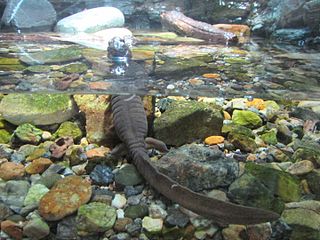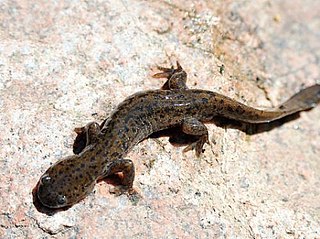 W
WHynobius is a genus of salamander in the family Hynobiidae, occurring in Japan, Korea, China, Taiwan and Far East Russia.
 W
WThe Abe's salamander is a species of salamander in the family Hynobiidae. It is endemic to Japan and known from southwestern Honshu in northern parts of the Fukui, Kyoto, and Hyōgo Prefectures. The specific name abei honours professor Yoshio Abe, a Japanese zoologist.
 W
WThe Ezo salamander or Hokkaido salamander is a species of salamander in the family Hynobiidae, endemic to Japan. Its natural habitats are temperate forests, temperate shrubland, swamps, freshwater marshes, intermittent freshwater marshes, freshwater springs, irrigated land, and canals and ditches.
 W
WHynobius formosanus, the Taiwan salamander, is a species of salamander in the family Hynobiidae, endemic to Taiwan, where it occurs in the high mountains at around 2,100 m (6,900 ft). Its natural habitats are from open alpine habitats to shaded moist evergreen forests. Adults have a total length of 58–98 mm (2.3–3.9 in).
 W
WThe Hida salamander or Hondo salamander is a species of salamander in the family Hynobiidae, the Asiatic salamanders. It is endemic to central and western Honshu, Japan. It lives in deciduous, coniferous, and mixed forests, where it breeds in streams. These salamanders typically spawn from February to April, leading some to metamorphose in late September while others wait for the following year to do so after winter is over.
 W
WThe Japanese black salamander is a species of salamander in the family Hynobiidae, endemic to Japan.
 W
WThe Korean salamander, or Gensan salamander, is the most common species of salamander on the Korean peninsula, and is also found in nearby provinces of China and on Jeju Island. It typically lives on forested hills, and from time to time mass deaths occur in Korea when salamanders encounter man-made drainage structures. This has prompted Korean government officials to execute a series of mass evacuations in heavily salamandered areas.
 W
WHynobius nebulosus, the Mitsjama salamander, is a species of salamander in the family Hynobiidae endemic to Japan. Its natural habitats are temperate forests, rivers, swamps, freshwater springs, and irrigated land. It is threatened by habitat loss.
 W
WThe Odaigahara salamander is a species of salamander in the family Hynobiidae. It is endemic to Japan. Its natural habitats are temperate forests, rivers, and freshwater springs. This species is threatened by habitat loss.
 W
WThe Oita salamander is a species of salamander in the family Hynobiidae endemic to Japan. Named after Oita Prefecture, its natural habitats are temperate forests, rivers, intermittent rivers, freshwater marshes, intermittent freshwater marshes, and irrigated land in western Japan. It is threatened by habitat loss, due to the increasing construction of homes within its habitat. The Oita Salamander is considered to be vulnerable by the (IUCN) Red List of Threatened Species with a declining population.
 W
WHynobius quelpaertensis, the Jeju salamander, also spelled Cheju salamander, is a species of salamander found on various islands and peninsulas off the southwestern coast of the Korean Peninsula, including Jindo, Geojedo, Jejudo, and Namhae. It inhabits moist mountain forests.
 W
WThe Taiwan lesser salamander is a species of salamander in the family Hynobiidae, endemic to Taiwan. The Taiwan lesser salamander is known from four localities in the central and northern part of the Syueshan Mountain Range; it appears to be scarce. Its elevation range is about 1,300–1,720 m (4,270–5,640 ft), which is the lowest among Taiwanese hynobiids. They live on densely shaded, moist forests and are found along mountain creeks or under rocks or rotting wood.
 W
WThe Tohoku salamander is a species of salamander in the family Hynobiidae, endemic to Japan. Its natural habitats are temperate forests and rivers.
 W
WThe Tokyo salamander is a species of salamander in the family Hynobiidae, endemic to Japan. Its natural habitats are temperate forests, freshwater springs, arable land, irrigated land, and canals and ditches. It is threatened by habitat loss. Many different species of amphibian have unbalanced sex ratios. This trend is no different in Hynobius Tokyoensis; the sex ratio between males and females is about 1.5:1. Although this does not play as large of a role as habitat destruction when it comes to the decline of this species, it is still significant.
 W
WHynobius yangi, the Kori salamander, is a species of salamander endemic to southeastern South Korea. It is a lentic-breeding species similar to the Korean salamander but is distinguished by factors including tail shape and dorsal coloration. The species is known from the vicinity of the type locality in Gijang County in northeastern Busan and from the nearby Ulju County in western Ulsan.